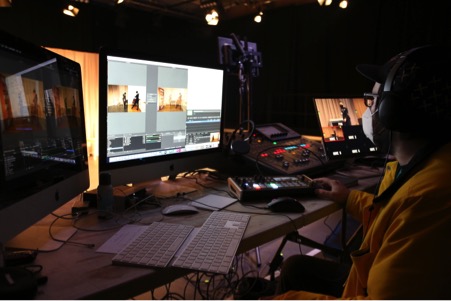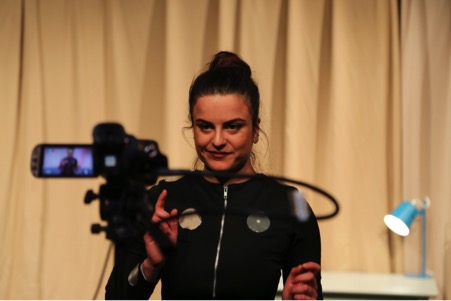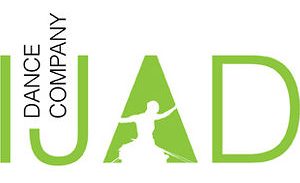
During the pandemic, IJAD Dance focused on Open Online Theatre,which allowed them to recreate and rethink how the performing arts sector could support young to midscale artists nationally during the closure of cultural venues and beyond.
We are not big, not an Amazon, or a Google…but we managed to deliver an ambitious programme for artists, beginning in September 2020 and culminating in a week-long live-streamed festival in February 2021, which involved work from 49 professionals.
We used five strategies to keep our approach fluid:
- Whatever’s happening, carry on!
- Build a space for process, questions, trust and support
- Be fluid and adaptable, be agile, nothing is personal, it’s ok not to be sure
- Always remember your North Star
- Know your team, and your collaborators
Whatever’s happening, carry on!
“The pandemic lockdown scenario(s) demand reflexive and immediate responses to explore and negotiate the physical chasm that has opened up between performer and audience, between lecturer and student, and between space and place.”
Paul Sadot
For a year now, the stories have been about empty: empty theatres, cinemas, schools, streets and community spaces.
And the question has been ‘how do we transform our habitats into spaces conducive to work?’
30 March 2020:We worked at full power while venues were working at 11 to 33% capacity. Email correspondences became a waiting game, like Dumas’ book, L’Attente.
The suspense was in waiting to see how directors would negotiate the absurdity of our new reality.
Immediate reflective responses were what we at IJAD were planning at the time; our momentum was ‘all systems go’ with Open Online Theatre, a virtual venue developing and showcasing new work at the intersection of performing arts and technology; training artists to rethink their practice to make work specifically for live-streaming, via the art of sensography.
IJAD wanted to create a system for artists to monetise their process and performances, and gain training in business and social media, as tools for sustainable careers.
March to June 2020:The first three months of the pandemic were about using our creativity, our listening ears and our communicative nature to work out how to create and supply what the market needed.
Yes, it took a lotof energy; it was very hard to find alternative spaces to perform and to devise methodologies to create between spaces, between times and between bodies.
The narratives, be they abstract or linear, are what we deliver through whispers, poems, words, visuals, movements, touches, and that is what we do as artists.
COVID-19 forced us to pause and to analyse, while we also faced living in fear, and the grief of knowing that friends and family members were contracting the virus or dying from it, while we were unable to visit the hospital to lift their spirits, or support the deceased family, or rejoice for a newborn baby.
Everything quickly became screen-based, and for this our emotions needed to adjust and learn a new way of existing.
Lockdown rules had imposed new spaces, new sensitivities and fears that were challenging both existentially and physically. This newly-pressed existence suddenly became a multitude of isolated existences.
As creators and performers that have been working in the telematic arena, we found ways to invite others to engage with the potentialities of this new performance architecture, this new spatiality.

OOT:Building a space for process, questions, trust and support
“I feel that as I move forwards as an artist, my thought processes will align with the
marriage of each of these components to push the boundaries of the art form.
I really feelthat a process like OOT at the time OOT came about, the different modes of thinking andmy own creative enquiry sitting in science tech and dance, resulted in a process that was very special to me.
Creating a space that reflects on invigorating our practice by using technology within the artwork we are creating, hence the hybridicity, this is a place where we are growing the community of intersection where tech and performing arts are pushing with the new. Hybrid is in the way we integrate the tech and science in the work and where the audiences receive the work.
This was muchmore than a professional artist development programme, but more of a supportmechanism to prepare me for all of the creative processes that I experience movingforwards.”
Lauren Tucker, OOT Artist
Rewind to January 2018:Five international artists trialled the Open Online Theatreprogramme, in its beta version; the programme ran for eight weeks, including three days of workshops in sensography, social media, editing, and film.
At the end of eight weeks, we had a sharing. The programme went well with no major issues; we had an international audience of 600, with 50 people present in the theatre. Artists had great freedom of choice, and live streaming happened as a natural flow.
March 2020:Two years on we faced completely new parameters: in terms of space, digital space, technological incapacity, human interactions, audiences with digital overload, and venues running at reduced capacity.
Fast forward to February 2021: The Open Online Theatre Festival reached 16 countries and 59 cities, hosted online, and from a gallery in France!
‘Be fluid and adaptable, nothing is personal, it’s ok not to be sure’
Joumana Mourad
It’s true,we had system that was successful in 2017-2018, but 2020 came along with entirely new demands: audiences had a ‘Zoom habit’ and digital fatigue, we had more easily accessible Facebook, Instagram, etc. and the artists had different needs.
February 2020:After looking for 10 talented artists to join the programme, we now had artists from Manchester, Birmingham, Devon, Greenwich, London, Brighton….
March 2020:We found ourselves in limbo, between two places, negotiating the space between home and studio, and re-imagining the home asthe studio.
Where are the choreographers, dancers, dramaturgs, performers, engineers, sound people, lighting people, set designers, curators? Where are they creating? Are they forced to pause? What happened to this abundant sector?
Creating art, performances, theatre, dance is what we are born with. It’s our breath – it asserts our existence.
For centuries, these representations have metamorphosed; creators became alchemists and kept on creating magic. In the last few years, through telematics, streaming, interactive design, games, street performances . . . the myriad of potentials has grown even more!

Image credit Katerina Sfaellou.
Always remember your North Star
“I really valued the opportunity to grow as an artist in directions I hadn’t expected while overcoming challenges with the support of dedicated mentors and discovering a new network of creative artists.”
O. Pen Be, OOT Artist
Our objective was to create a space where all the artists could be together, and share the experience of all the elements of the programme.
August 2020: The Beirut explosion prompted IJAD to subsidise a Lebanese dance artist to join the programme. There were issues with wi-fi connectivity, but we managed by purchasing a 4G installation at the artist’s studio.
November 2020:We embedded in the programme was a two-day mid-point meeting to go over elements of sensography, and have a sharing of the artists’ works in progress. It coincided with the beginning of the second lockdown, so we quickly adapted it – and our marketing and communications – to be held online.
Our festival date at the end of November was looking questionable; in fact, everything we had planned soon became impossible and the uncertainty of a longer lockdown took its toll on the whole team. The theatres we were working with had less and less flexibility; some had bookings that we were unable to compete with cost-wise.
All the participants and IJAD’s team made a joint decision to postpone the festival until the beginning of February 2021.
OOT artists were offering workshops and co-creation sessions, IJAD was hosting roundtable discussions, there were artists’ Zoom meetings, all of which kept the mood positive.
The glimpse of the New Year ahead came with some optimism. Our plans for the festival in February were taking shape. We’d decided to host some panel discussions, and everything was looking good as momentum built.

Image credit Katerina Sfaellou.
Know your team, and your collaborators
“I am very grateful for the opportunity; I have learnt a lot about my creative practice and
developed as a person along the course of this programme.”
Daisy Harrison, OOT Artist
4 January 2021:After a day filled with incredible meetings to make plans for the festival, Boris Johnson announced longer strict lockdown measures. Monday night became another sleepless night filled with new plans and strategies. And deciding whether to deliver the festival or not!
5 January 2021: We spent time waiting for government website updates, talking to colleagues in our industry and to dance bodies, with everything and everyone telling us to wait. This was heavy going as there was still a lot to put in place should we decide to go ahead.
We decided internally that we would keep on preparing, and only in the worst-case scenario would we cancel. By 3pm, we had taken on a Covid health and safety production manager, to navigate the complex safety rules. This was a brilliant investment, as we had someone on board who would act diligently and professionally, giving us accurate information, enabling the team to make informed decisions together.
6 January 2021:After more meetings, and clearer guidance from the government, we decided – with the support of our artists – to definitely go ahead with the festival.
6-8 January 2021:Looking for a festival venue with all the health and safety strictures in place took time and endless emails, many of which went nowhere.
Finally we identified one and loved it! We had a date, we had a theatre, and we still had the uncertainty of lockdown.
11 January:A meeting with the artists. Six hours of sharing narratives, performances, choices around continuing to create, finances, ethics, payments for all the artists, lockdown, lockdown and more lockdown.
Two artists chose to be physically present in the theatre for the festival, another from her kitchen, the rest from their living rooms.
We had until 1 February to pull the festival together, which included six performances and four panel discussions.
It goes without saying our team was dedicated, focused, and more than anything committed to the arts. There was somuch wisdom, kindness and 100% support.
Covid taught us: Be kind, sensitive, grounded and elastic.
If you’d like to stay up-to-date with our work,sign up to our newsletter.
Image credit Katerina Sfaellou.
Thanks to


